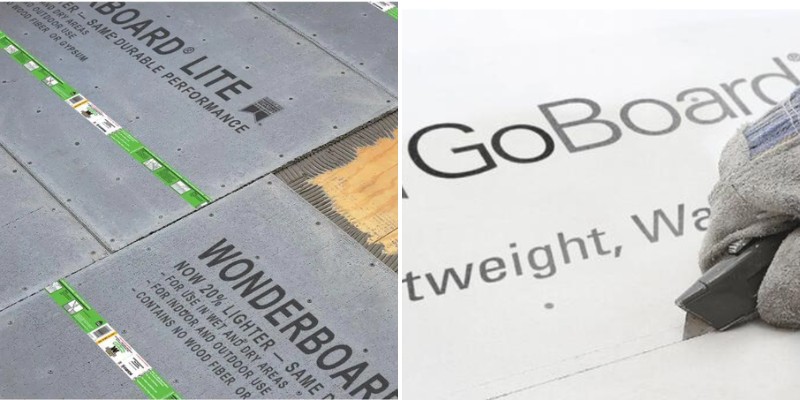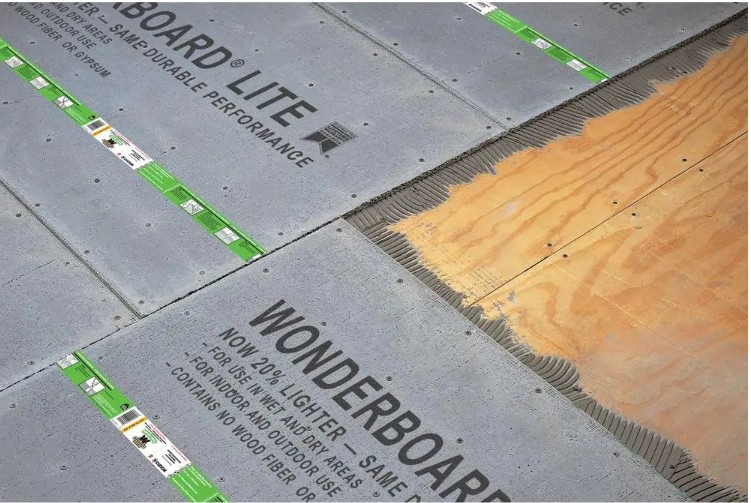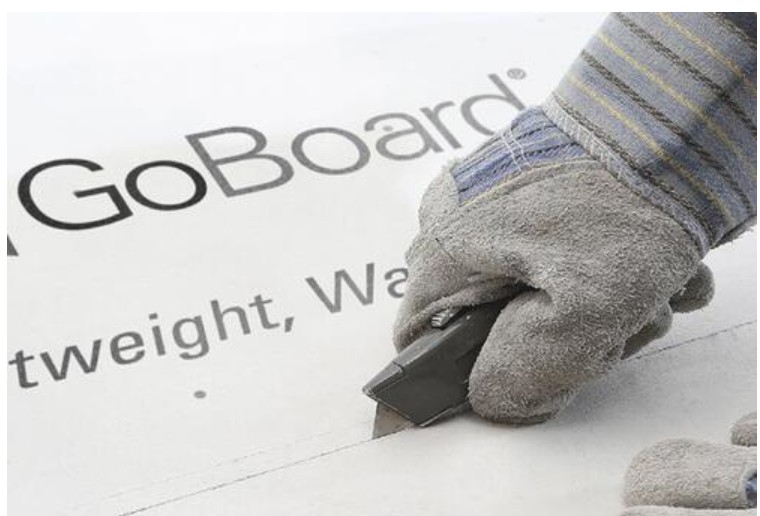Two popular backer board brands are WonderBoard and GoBoard that can be used for various applications in the construction and home industry, such as for tiles, walls, ceilings, showers, flooring etc.

In this article we’ll compare Wonderboard vs Goboard and describe some of their characteristics and use-cases for each one.
Tile backer boards are substrate materials onto which tiles are applied. Backer boards are flat, hard, and dimensionally stable.
Ceramic, stone, or glass tiles can be adhered to the backer board using a thinset adhesive mortar.
Tile backer boards are either moisture-resistant or waterproof, unlike gypsum drywall and wood.
This makes them an ideal substrate to be used in wet areas, such as showers, steam rooms, indoor pool areas, bathrooms, and laundry rooms.
What is WonderBoard?
WonderBoard Lite is a cementitious based backer board that is conventionally used as a substrate for the application of tile.

It is basically cementitious particles that are bonded and layered between two sheets of fiberglass mesh.
While the material is porous, it does not degrade in the presence of moisture, making it a solid backing for ceramic, stone, and glass tile in wet areas.
WonderBoard is available in 3×5 foot sheets in either 1/4-inch or 1/2-inch thickness.
What is WonderBoard Used For?
WonderBoard sheets are ideal as an underlayment for tile in wet areas for both interior and exterior applications.
Thinset adhesive mortar is troweled onto the surface of the prepared board to allow for the tile to adhere to the surface.
Moreover, WonderBoard is also used as a finish material for exterior areas, such as the ceiling of an entrance canopy.
The seams can be taped and coated with compound, similar to gypsum wallboard. Then, the entire surface is coated with a waterproof finish and painted.
The manufacturer of Wonderboard Lite (“Custom Building Products”) states that this product is not a waterproof barrier. If you want the area behind the backer board to remain dry, then you must use RedGard® Waterproofing and Crack Prevention Membrane.
Can You Use WonderBoard on Shower Walls?
You can absolutely use WonderBoard on shower walls. In fact, it is a perfect tile backer board for showers and steam rooms (but have in mind the statement above about RedGard for waterproofing).
It can even be used on seating platforms and shelves in wet areas. When properly installed cement backer boards will create an extremely durable substrate for your shower wall tile installation.
Do I Need to Waterproof WonderBoard?
WonderBoard is extremely water-resistant. However, it isn’t waterproof. The fasteners, seams, and corners need to be sealed.
As well, the entire board surface needs to receive a liquid waterproof sealer before installing the tile finish.
Alternatively, you can install a waterproof material and membrane (e.g RedGard and Crack Prevention Membrane) over the framing prior to attaching the WonderBoard to deter moisture from getting to the boards.
What is GoBoard?
GoBoard is an ultra-lightweight waterproof tile backer board. Unlike cement-based backer boards, GoBoard has a core made from polyiso foam, it can be cut with a utility knife and does not create dust etc.

It is extremely light and easy to handle, even for the DIYer. This type of board can be cut with a standard utility knife with minimal dust as mentioned above.
GoBoard is available in 3×5 foot or 4×8 foot boards. 1/4-inch and 1/2-inch thick boards are ideal for residential applications. 5/8-inch boards are well suited for floors and more heavily trafficked areas.
What is GoBoard Used For?
GoBoard tile backer boards offer a stable surface on which to bond tile. It can be used on floors, walls, ceilings, and countertops where a waterproof substrate is desirable.
This product is especially appealing for residential projects where a homeowner or smaller contracting business can easily do the installation with hand tools, such as a utility knife and a hammer. Power tools are not required.
Is GoBoard Good for Showers?
Polyiso foam boards are definitely good for showers. Because GoBoard is a lightweight material, it is very easy to install on shower walls, ceilings, floors, and benches. They are also great for steam rooms.
Does GoBoard Need to be Waterproofed?
GoBoard is a waterproof material. Yet, the edges, joints, and fastener locations are not waterproof and need to be sealed to protect the entire system.
If using mesh tape and compound mortar instead of polyurethane joint and fastener sealant, you can also apply a liquid waterproofing over the entire surface for added protection. However, this is not required by the manufacturer but it is highly recommended for extra waterproofing.
Comparison of WonderBoard and GoBoard
Wonderboard
WonderBoard is a cement-based tile backer board. Cement boards are durable and dimensionally stable. However, they can be heavy and will produce a crumbly dust when cut.
WonderBoard is installed with screws. The seams need to be taped and sealed with compound.
Contractors find Wonderboard as more difficult to work with as it tends to crumble easily.
Finally, WonderBoard is coated with a waterproof sealant before the tile is adhered to it.
An advantage to WonderBoard is that it is considered a good product for certain exterior finishes as long as it is properly waterproofed.
GoBoard
GoBoard is a polyiso foam tile backer board that has 80% less weight than cement boards.
Foam boards are lightweight and easy to cut and install (with just a utility knife). These boards can be attached to wood or metal framing with screws, nails, or staples.
The seams need to be sealed with polyurethane caulk. The advantage of using foam boards is that it saves time and labor costs because you can tile over it the same day that it is installed and is easier to work with.
Comparison Table
| WonderBoard | GoBoard |
| Water-resistant but not waterproof | Both water-resistant and waterproof |
| 3’x5’ foot sheets | 3’x5’ or 4’x8’ foot sheets |
| cement and aggregate core with a fiberglass mesh | Polyiso foam board |
| Higher mass product | Lower mass |
| Cheaper than HardieBacker | Similar price as WonderBoard |
| A little harder to work with | Easier to work with |
Related Posts
- Comparison of HardieBacker Cement Board vs Plywood For Tiling Projects
- 6 Great Alternatives to HardieBacker Cement Board
- How Much Does it Cost to Furnish a House – Living Room,Bedroom,Kitchen etc
- 5 Benefits of Spray Foam Insulation During Summer
- Here are Some Plumbing Installation Tips For your New Home
- 15 Stores Like Home Depot for Your Home Projects (Great Alternatives)
Leave a Reply